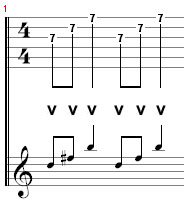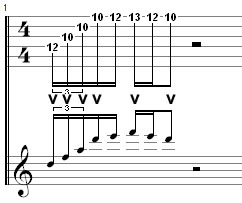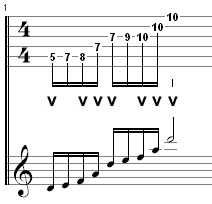The sweeping
Sweeping is a technique in which several strings (from 2 to 6) are picked in a unique movement. Sweeping in Manouche style is restricted to downwards motion (due to the downstroke-on-string-change rule) to keep the attack powerful. This is needed because the style in mainly acoustic. Upwards sweeping is OK on electric, or at least amplified, guitars. Ideally, one note should ring at a time. This is just to emphasize that left ahnd-right hand synchronisation is very important. That also means that once a note is played, it should be muted with any finger available on the left hand as soon as the next note is picked. However, in some cases, it's fine to let ring too.
Contents
Simple sweeping
To start easy with sweeping, here's an exercise where three strings are swept. Focus on this unique movement. The important thing is that is has to be regular/timely, so that when a sweeping is immediately followed by an upstroke or by another not-swept downstroke, it does not make a timing difference. Work this with a metronome without speeding too much.
Simple sweeping on the three high strings

|
Simple sweeping on the four high strings and one alternate picking from "Les Yeux Noirs"

|
Repetitive sweeping
This kind of sweeping on three or four strings is useful as an exercise but can also be reused in a concert context, particularly on diminished and dominant 7th chords. Stochelo use them quite often. Pay attention to the fact that you should not slow down when moving the pick upwards back to the D string.
4-note sweeping on diminished chords

|
3-note sweeping and an upstroke the Stochelo way
Play each pattern twice (only written once on the music sheet)
Arpeggio sweeping
Vertical arpeggios often call upon 3- or 4-note sweeping. This lick is often reused in choruses.
| ici sur Ré mineur |






